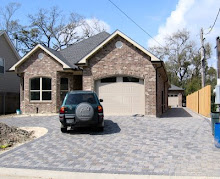My architect asked me if I wanted to do post-tensioning on the slab or use traditional rebar. When using rebar, they lay a grid of iron rods (the rebar) on the ground where the slab will be poured. When the pour is done, the rods wind up suspended in the concrete to make it stronger (or at least resistent to cracking. If it does crack over time, the rebar acts to keep the concrete from separating too much. So rebar can't prevent cracks, but it does minimize them and help keep them from getting worse.
Post-tensioning embeds a grid of steel cables across the slab with extra cable sticking out around the borders. The cables are encased in plastic sleeves to keep them from rusting out over time. A short time after the concrete is poured, a hydraulic jack is used to pull the cables tight all around. Then the extra lengths are snipped off. This post-tensioning is done before the concrete sets fully. The idea is that you're putting pressure on the slab while it finishes setting. Concrete under pressure is stronger than it would be otherwise. So post-tensioning should do more to prevent cracking in the first place.
This method is newer than using rebar, at least in residential construction. Another benefit of post-tensioning is that it supposedly lets you use a thinner slab than you would with rebar. This would help you save money.
The architect also described it this way: With rebar, they have to come out and get all the rods in place in and around the trenches that need to be dug for footings, etc. If it rains before you pour, they need to come out and clear out all the sand that washed into the trenches. The rebar makes it difficult to do, so you lose time. He said this concern is reduced when using post-tensioning. I'm not sure why the having rebar there would be different than having cables there if the rain should occur. I'll have to ask him or a slab company more about it.
So post-tensioning hasn't been used as long as rebar. Hmm... Like all new building methods, I wonder how experienced local contractors are with it. Would I be able to find someone who knew what they were doing? I've only seen two houses being built around here that used this method. And is it really proven? Once a house is in place for a number of years with a post-tension slab, is it really all that it's supposed to be?
Subscribe to:
Post Comments (Atom)

No comments:
Post a Comment